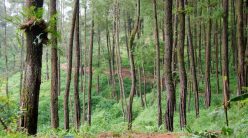An updated version of these notes can be accessed from a new “Avian Biology’ page
(http://people.eku.edu/ritchisong/avian_biology.html).
Birds use nests to protect eggs and nestlings from predators and adverse weather. To minimize predation, birds may use or build nests that are inaccessible, hidden, or camouflaged. Nests may also help keep eggs and nestlings warm.
Orientation and microclimate of Horned Lark nests — Across their range, Horned Larks typically construct nests adjacent to & north of objects such as a tuft of grass or a rock. Hartman and Oring (2003) studied the importance of nest orientation to nest microclimate in Horned Larks in California. Nests showed a significant northern bias in orientation angle and were 49% shaded in the early afternoon, the hottest part of the day. Artificial nests of eastern, western, and southern orientations exhibited little to no shade during this time. A northern nest orientation ensures maximal shading by the grass tuft to the south, may protect nests from cool evening winds, and provides increased daytime ventilation of the nest through exposure to prevailing winds. In addition, shade may also help conceal nests from predators.
The position of vegetation (curved black bars) around Horned Lark nests relative to the direction of prevailing winds. The dashed circle represents the outline of a nest. Each individual curved black bar represents the vegetation around one nest. Each solid circle represents one entrance orientation. The dashed line designates the mean entrance orientation angle of 345° for all nests (n = 10; Hartman and Oring 2003).
Types of nests:
• Scrape nests are simple depressions in the ground (sometimes with a few stones added) or in the leaf litter. Such nests are used by some penguins, shorebirds, gulls, terns, nighthawks, vultures (e.g., Black Vulture nest below), and other species.
Are wader nest scrapes adaptively designed to minimize clutch cooling rate? – Arboreal avian nests likely function partly to insulate clutches. However, reasons for the construction of nest scrapes are poorly understood. Working on Pectoral Sandpipers, Dr. Jane Reid tested the hypothesis that using a lined scrape reduces the rate of clutch heat loss & investigated whether scrapes are effectively designed to minimize heat loss rates. The use of both an unlined scrape and of lining material reduced the rate at which a test object lost heat. Constructing a lined scrape is therefore likely to serve to insulate a clutch. The rate of conductive heat loss from within a scrape increased with scrape depth and decreased with lining depth. Convective heat loss increased with wind speed in shallow scrapes but not in deep scrapes. Mean observed scrape depth approximately equaled that which minimized convective cooling while minimizing conductive heat loss. Further, on average, Pectoral Sandpipers used approximately the lining depth that minimized conductive heat loss while minimizing material useage. Scrape dimensions therefore approximated those likely to minimize overall heat loss, given the conflicting thermal pressures of the environment. Available lining materials differed in insulative quality both when wet and dry. Pectoral Sandpipers did not use lining materials in proportions that reflected local availability. Instead, relative use was correlated with a material’s insulative quality when wet. Pectoral Sandpipers therefore used lining materials appropriate to minimizing heat loss given their damp breeding environment. – Jane M. Reid, University of Glasgow
Burrow nests are very effective at protecting eggs and young from predators & maintaining an appropriate microclimate for eggs & young. Some birds, like Bank Swallows and Belted Kingfishers (pictured below), usually construct their own burrows, while others, such as Burrowing Owls, may use burrows contructed by other species.
Spacing of Bank Swallow tunnel entrances (Ghent 2001) — Tunnel entrance distributions at six Bank Swallow sand-pit colonies showed consistently nonrandom, too-regular patterns, supporting the hypothesis that the distance between tunnel entrances is determined by territorial disputes at the Average nearest neighbor distances, and numbers of burrows per unit area of pit face, were both consistently greater than their random expectations, a paradox that is explained algebraically. Evidence of tunnel coalescence and communal nesting was found in a completely evacuated colony of 30 tunnels. Bank Swallow colonial behaviors may have evolved to maximize populations on small exposed bank faces along streams and rivers, and that they are still behaving as if only small fractions of large sand pit banks are available. On small areas, regular spacings help to avoid too close tunneling and concomitant bank collapse. It is argued that a tolerance for communal nesting, once coalescence has occurred, involves less tunneling than the forced evacuations of entirely new tunnels by ousted pairs.
Cavity nests (e.g., in trees or cacti) are used by numerous passerines, woodpeckers, owls, parrots, and some waterfowl. Some birds, such as woodpeckers (like the Gila Woodpecker below), construct their own cavity nests and are referred to as primary cavity nesters. Species that use natural cavities or cavities constructed by primary cavity nesters are called secondary cavity nesters.





